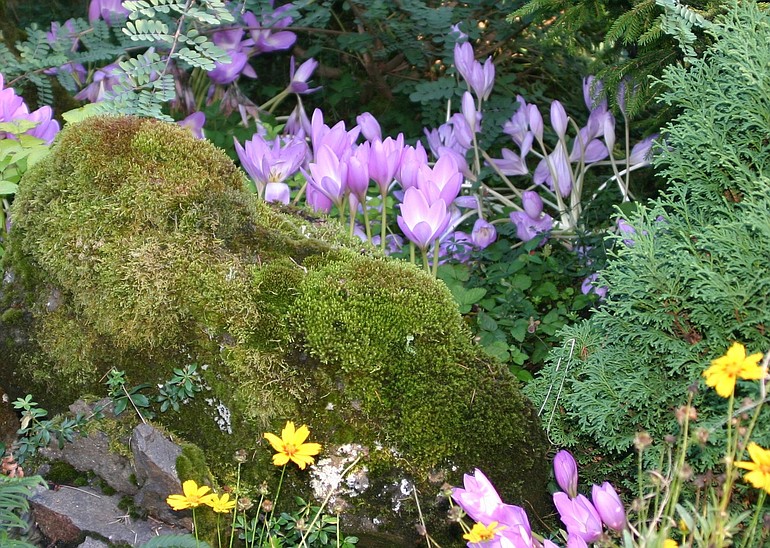Planting to reflect the distinct seasons of the year is part of the gardening experience in the Pacific Northwest.
The chilly evening air can no longer be denied, and it brings with it a distinct seasonal color palette. In anticipation of the changing fall garden, it makes sense to add deciduous trees and shrubs for their burnished autumn foliage.
Those of us still willing to work in the autumn garden are surrounded with splashes of surprisingly bright seasonal color. Many perennials and bulbs only begin to flower as the days grow shorter. Japanese anemone (Anemone x hybrida) blooms in late summer and flowers well into fall. The hardy cyclamen is long-lived and self-sows freely. A naturalized colony can establish in just a few years.
Hardy cyclamens are terrific autumn perennial corms or tubers that produce prolific fall blooms, even in hostile garden conditions such as dry shade. Cyclamen hederifolium and C. coum are both autumn bloomers. They are beloved for their late-season flowers with backward-folding petals. They are similar to the florist cyclamen with smaller flowers in greater numbers. They are truly maintenance free.
Fall is a great time to add a new planting area to your garden. A border with all-year interest contains a mix of trees, shrubs, vines and perennials. We can count on autumn rain to water new plantings, while the warm soil and cool air assure us of ideal conditions for planting and transplanting. As long as you are prepared to protect young plants from unexpected freezes, you can also plant needled and broad-leaf evergreens in the fall.
In general, taller plants go farther back in the border area; shorter ones in front. Unless you are creating a formal garden border, plant in odd-numbered groups and stagger plants rather than planting in straight lines. Your garden is a reflection of your own personality, so break the rules when it feels right. Midsized ornamental grasses and “see-through” plants such as Verbena bonariensis add interest near the front of a border and allow the color of flowering perennials to show through their wispy outlines.
A vast selection of hardy asters is available in innumerable colors at this time of year. Since they are in full bloom now, you can try them in different areas of the garden to make sure that their strong colors mix well with existing plants.
Start by positioning your newest acquisitions in the flower border while they are still in their nursery containers. This way you can move them around as many times as you want to get the most pleasing layout.
Once everything is laid out as you like it, walk away from the area and take a visual break. When you approach the garden again, do so as if it is already established and in full bloom. As much as planting, weeding and digging, envisioning the garden a year from now is a fundamental skill that every gardener needs to cultivate. When you are satisfied with the arrangement, plant and water well.
Consider planting at least one large sweep of a single plant variety to give the bed a strong focus. Make a sweep by placing groups of three plants in triangular formations, then connect with another triangle until you have the size of grouping that will make a statement and fit the size of your garden. At the very least, stagger the plants in a well-spaced, natural zigzag pattern, rather than in a row. Think of daisies in a meadow or grasses on the prairie.
Play with new ideas and take chances. You can always change things around next year. Try planting several areas of the garden with flowers that will bloom in successive seasons. Choose any combination of your favorite spring, summer and fall flowering plants. Choose colors that will mix with each other just in case the bloom of one season lingers on into the next. One example would be pastel tulips, powder pink bleeding hearts and golden hued chrysanthemums.
Consider a mass planting of the blue and white Crocus “Pickwick,” a pink flowering peony and a large cluster of Sedum spectabilis “Autumn Joy.” End the season with a sweep of rosy-pink asters, their golden eyes shimmering in the noonday sun. By adding a backdrop of shiny, evergreen holly with red winterberries or the horizontal branching silhouette of a “Shasta” viburnum, you can create a four-season garden in one fell swoop.
Robb Rosser is a WSU-certified Master Gardener. Reach him at Write2Robb@aol.com.



